Tesla’s V4 chargers represent the pinnacle of fast-charging technology, blending speed, convenience, and cost efficiency into an experience unmatched by competitors. It’s an achievement that overshadows Musk’s polarizing persona and challenges even the most anti-Tesla EV owners.
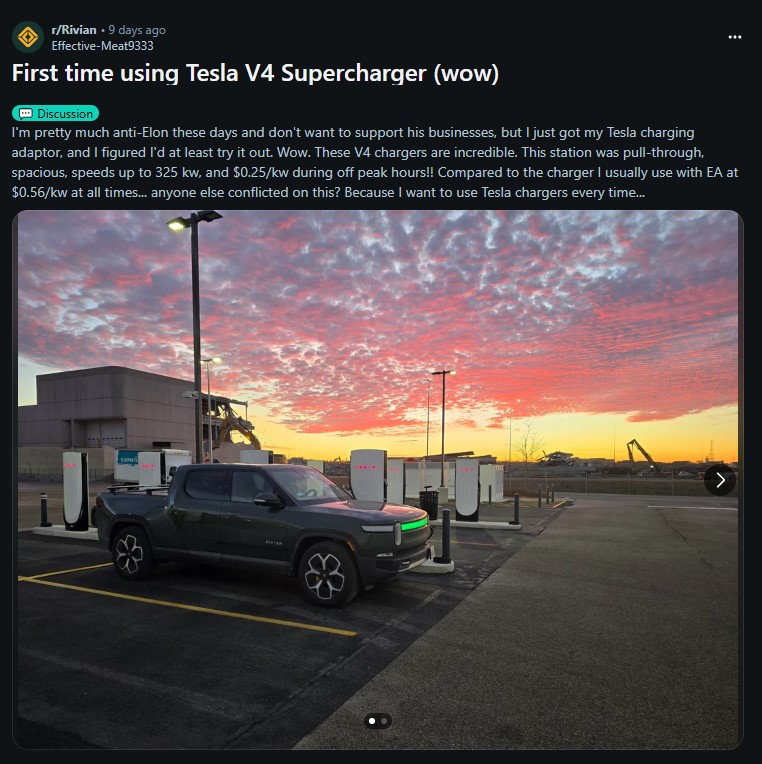
As one conflicted Redditor confesses,
“I’m pretty much anti-Elon these days and don’t want to support his businesses, but I just got my Tesla charging adapter, and I figured I’d at least try it out. Wow. These V4 chargers are incredible. This station was pull-through, spacious, speeds up to 325 kW, and $0.25/kWh during off-peak hours!! Compared to the charger I usually use with EA at $0.56/kWh at all times… anyone else conflicted on this? Because I want to use Tesla chargers every time…”
Tesla V4 Superchargers vs. Electrify America
Electrify America, once envisioned as Tesla’s great rival, has stumbled with reliability issues, mediocre speeds, and flat-rate pricing that often feels extortionate. Tesla, on the other hand, offers convenience and consistency: chargers that work every time, layouts designed for usability (such as pull-through stalls for vehicles with trailers), and blistering speeds of up to 325 kW.

For Rivian drivers who thrive on the open road or off-grid trails, these stations are a lifeline. Pair that with a $0.25/kWh off-peak rate, less than half of EA’s $0.56/kWh, and it’s easy to see why even die-hard Musk critics find themselves reluctantly plugging in.
Tesla Supercharger Network
- As of 2025, Tesla operates over 7,000 Supercharger stations worldwide, equipped with more than 65,800 connectors. This expansive network spans major regions, including North America, Europe, and Asia Pacific, facilitating long-distance travel for Tesla owners.
- Tesla's Superchargers can add up to 200 miles of range in just 15 minutes, addressing one of the most prominent concerns regarding EVs, the recharge time.
- Tesla continues to innovate its charging infrastructure, with plans to introduce V4 Supercharger stations supporting up to 500 kW charging for electric vehicles and 1.2 MW for Tesla's commercial Semi trucks. These advancements aim to reduce charging times and accommodate a broader range of EVs.
Let’s be real, cost matters. The Rivian R1T, with its 135 kWh battery, costs around $33.75 for a full charge at a Tesla Supercharger during off-peak hours. The same fill-up at Electrify America runs $75.60.

That’s a $41.85 difference, enough to sway even the staunchest Tesla opponent. Over the course of a year, with frequent use, those savings quickly scale into the hundreds. While some might argue that principles are priceless, EV owners often face a stark choice between ideals and practicality—especially when they’re sitting at 10% charge in a remote parking lot.
Tesla V4 Chargers
The technical superiority of Tesla’s chargers compounds this dilemma. Rivian’s R1T and R1S are built to handle high-speed charging, but few CCS stations can reliably deliver the 300 kW these vehicles are capable of consuming. Tesla’s V4 stalls, however, are perfectly suited for the job, thanks to their robust design and forward-thinking infrastructure. The result? Rivian owners can charge faster and more efficiently on Tesla’s network than on most CCS alternatives, making Tesla’s ecosystem an undeniable draw, even if it comes with the baggage of Musk’s empire.
Rivian Adventure Network
- The Rivian Adventure Network offers DC fast chargers capable of delivering up to 150 miles of range in approximately 20 minutes for the R1T and R1S models.
- Rivian aims to establish over 3,500 fast chargers at more than 600 sites across the U.S. and Canada, focusing on locations along popular routes and in adventurous destinations.
- Initially exclusive to Rivian vehicles, the Adventure Network is now opening to all electric vehicle owners. The first such site, featuring a new design with larger displays and tap-to-pay options, was launched near Joshua Tree National Park in December 2024.
Of course, Rivian is not blind to the problem. Their Adventure Network is a targeted solution aimed at building CCS stations near outdoor destinations and off-road trails, catering to the brand’s rugged, adventurous ethos. But with only 50 stations nationwide, it remains a fledgling operation compared to Tesla’s expansive Supercharger network. For Rivian owners today, the choice to stray from their proprietary network often isn’t just a matter of convenience—it’s a necessity.
EV Charging Dilemma
This moral tug-of-war is emblematic of the EV industry’s growing pains. Tesla’s decision to open its network to non-Tesla vehicles isn’t just good PR; it’s a tactical move to dominate the charging landscape entirely. Meanwhile, Electrify America’s struggles and Rivian’s nascent network underscore how difficult it is to build the infrastructure needed to support widespread EV adoption. Tesla’s early investment in charging technology has given it a monopoly on the EV ecosystem that even reluctant users can’t ignore.
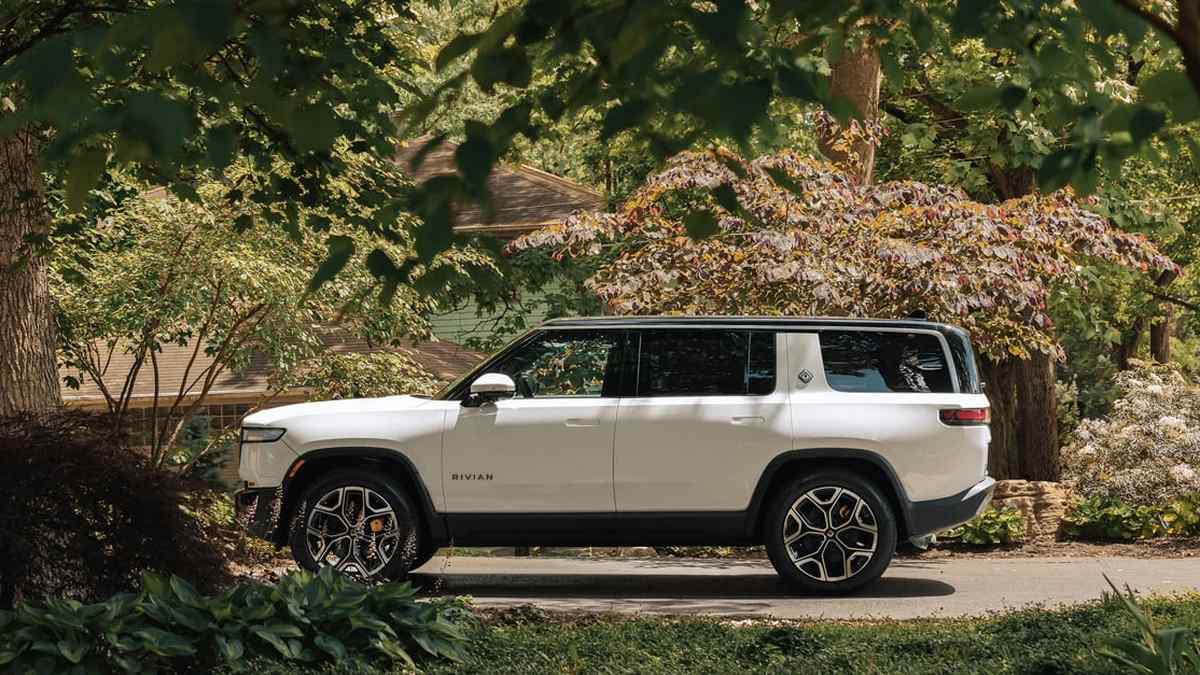
The Rivian R1T, with its exceptional engineering, off-road capabilities, and eco-conscious design, is a triumph of modern EV craftsmanship. It’s a vehicle that represents the freedom and independence many EV drivers value most. But even this symbol of rugged individuality relies on Tesla’s charging network to reach its full potential. For Rivian owners, the Tesla V4 charger is more than just a tool, it’s a paradox. It’s the road back to practicality, speed, and affordability, even if it means swallowing their pride. The future of EVs might be electric, but for now, it’s Tesla’s world, and we’re all just charging in it.
Noah Washington is an automotive journalist based in Atlanta, Georgia. He enjoys covering the latest news in the automotive industry and conducting reviews on the latest cars. He has been in the automotive industry since 15 years old and has been featured in prominent automotive news sites. You can reach him on X and LinkedIn for tips and to follow his automotive coverage.



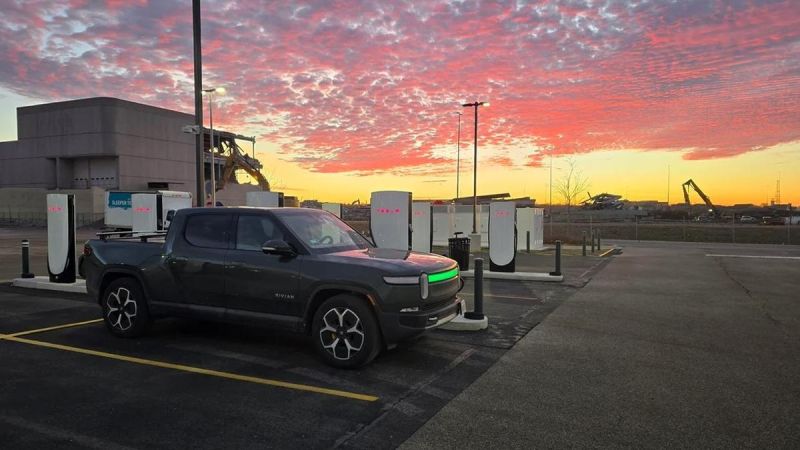




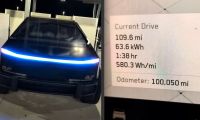

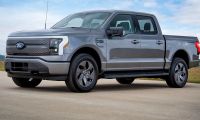
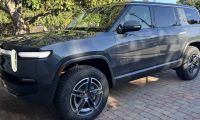
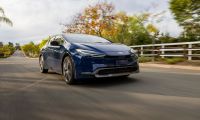
Comments
As mentioned in the article,…
Permalink
As mentioned in the article, charging rates are for “off peak” hours, but it should be highlighted that rates can easily double (& more) during “peak” hours. Here’s a screen shot of a mid afternoon example in Redlands Calif showing $.48/hr
That makes sense, thanks for…
Permalink
In reply to As mentioned in the article,… by AJ (not verified)
That makes sense, thanks for sharing.
One thing the Reddit user…
Permalink
One thing the Reddit user and author didn't make clear is that the max DC charging for the Rivian R1 series is 220 kWh. So any DC charging, whether Tesla, EA, or otherwise, that can provide anything beyond 220 is irrelevant with regards to Rivian R1T or R1S, but the $0.25/kW is definitely a plus especially on long road trips.
Evgo has TOU rates as well…
Permalink
In reply to One thing the Reddit user… by Chuck (not verified)
Evgo has TOU rates as well. It never gets as low as.25 (.42 I think) and only from midnight to
4 am. The circle K in Ellensburg was .46 I think over Christmas (cheapest in town). Superchargers are usually around .56 so I shop around when I can. In Canada Flo seems to be the best bet. The nice thing about electricity is it's all the same! No bad gas.
I haven't seen a circle K…
Permalink
In reply to Evgo has TOU rates as well… by voganni (not verified)
I haven't seen a circle K with chargers before.
I agree, for long trips it…
Permalink
In reply to One thing the Reddit user… by Chuck (not verified)
I agree, for long trips it would be nice.
Why would the writer not…
Permalink
Why would the writer not want to support Tesla?
Maybe he hates free speech? Maybe he loves sending billions of $$$ to foreign countries to help them mutilate children.
Better to keep those sick preferences quiet.
"I dislike supporting Tesla…
Permalink
"I dislike supporting Tesla."
Yep, removed your site from all future recommendations for my articles. So long.